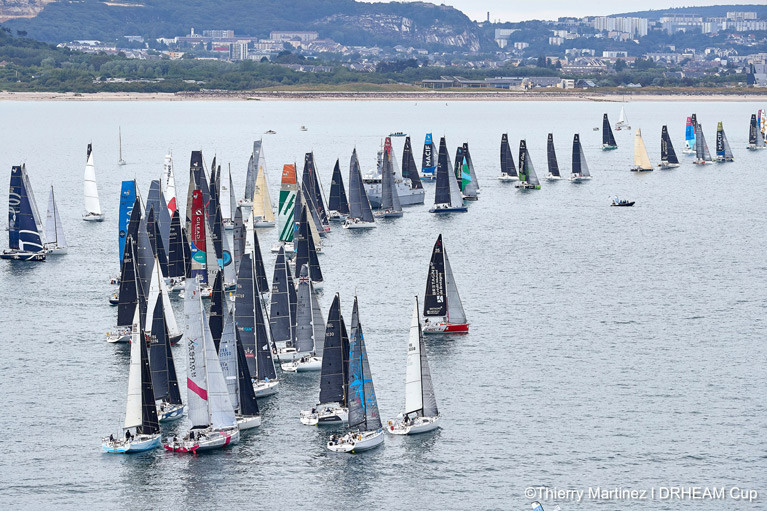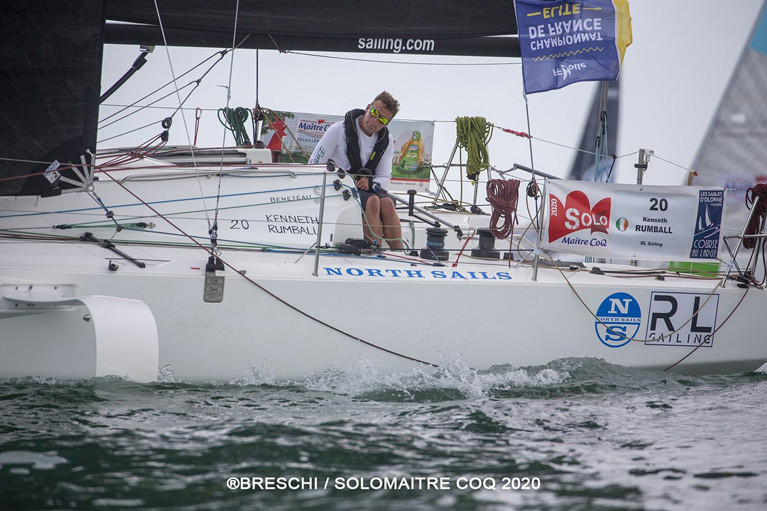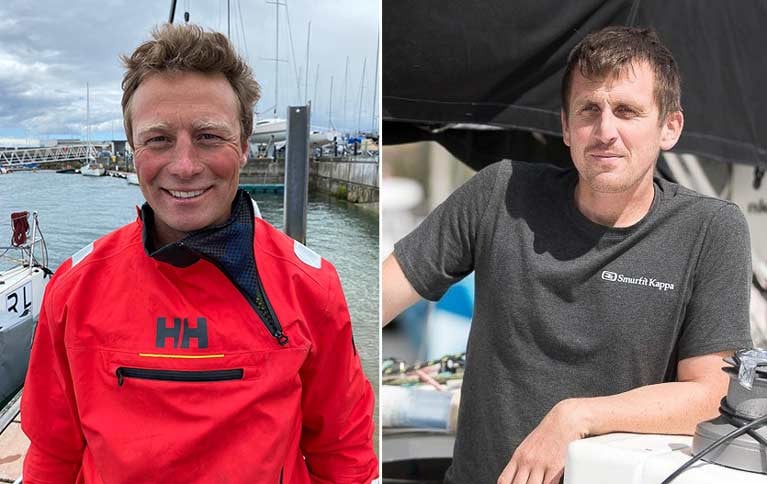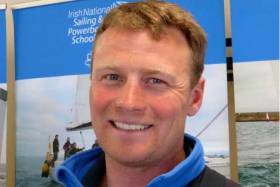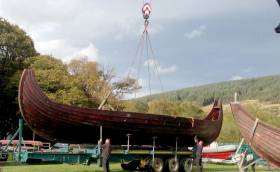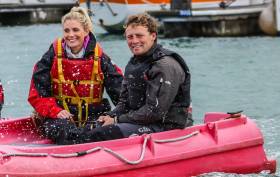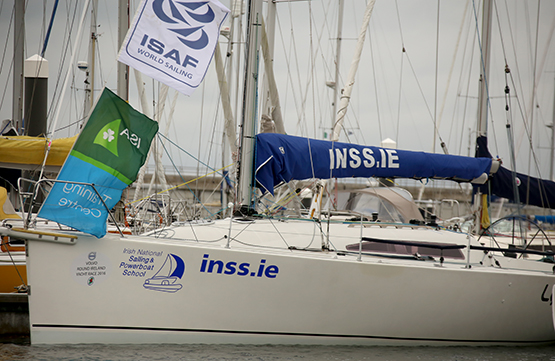Displaying items by tag: Kenneth Rumball
Dublin rookie Kenneth Rumball reflects on the Solo Concarneau Race, his last lead up race before next month's Solitaire Du Figaro debut
Our final training race before the big one in a few weeks (GULP!) was the Solo Concarneau 2020. Originally to be used on its initial date in May as the Irish qualifier for the team to represent Ireland at the inaugural Doublehanded Offshore Worlds that have obviously now been cancelled. This race, as per the original schedule would have been one of the first races of the Figaro season and my first race together with Pamela Lee as RL Sailing Team. Of course, now so late in the year, it was a solo race. Racing out of Concarneau was nice as we only had a 30 minute delivery from our base in Port La Foret and we could essentially stay at ‘home’ which cut out many days before and after a race.
 (Above and below) The Solo Concarneau 2020 fleet
(Above and below) The Solo Concarneau 2020 fleet

We had not raced since the Dhream Cup in which we had highlight speed deficiencies in a range of conditions. For the most part, we are slightly on the back foot as we have not had the opportunity to get any solid coaching due to the timescale imposed by the constraints of COVID -19. However, we have been spending a lot of time talking to our friends in the Figaros and trying to figure out how to make these little boats go faster. It should be noted, these are one-design offshore boats, where all the boats are identical, therefore it is totally up to the sailor to make the boats go faster. Most offshore sailing is done in a range of different boats where the results are based on a time factored handicap system afterwards. With the boats going at much the same speeds it leads for close, intense and stressful racing, you can never relax! For those reading who sail one-design dinghies, a dinghy race is typically 45 minutes, our races are typically 48 hours!
 The 270-mile Solo Concarneau 2020 course
The 270-mile Solo Concarneau 2020 course
Back to the race - the weather outlook was for very light conditions, the organisers had the opportunity to give 4 different length courses depending on the conditions. They decided on a course of 280 miles which brought us out of Baie de La Foret and along the coast, following it north through the incredibly tidal Point du Raz, where tides can hit up to 6 kts! From here we were to round a South Cardinal just south of Quessant before heading south to round Phare Birvideaux (Northern most rounding mark in the Solo Maitre Coq). The course then had us staying inside the island of Belle Ile and rounding a mark south of the island before heading north to home!
 Kenny Rumball heads out for the start of the Solo Concarneau
Kenny Rumball heads out for the start of the Solo Concarneau
Start day came and as our experience and confidence grows we are continually much more proficient with the safety and measurement checks, prop shaft seal controls etc. The wind was light, light, light for the start. I planned to simply get off the line in clear air as there was so little wind… I failed! I got pinned by a boat to leeward, who ended up ruining the start for both of us. The boat in question was definitely not thinking about overall strategy! Finding myself spat out the back yet determined to improve event after event, I set to work in the blistering heat (I forgot to mention that we are in a mid-summer heatwave in France). Taking a few educated risks and pouring lots of effort into sail trim, I picked up speed and started to claw my way back into the fleet, one boat at a time. I brought the boat so close to some of the islands that I could have tipped my weather foil off the rocks if I had wanted to!
 Another drifting start for the Figaros!
Another drifting start for the Figaros!
We were beating and close fetching, so there was a lot of Code 0 action or J2 with a full main. Our North Sails inventory really came to the fore here as for the first time I started to drop a boat here and there. You cannot imagine the confidence boost that comes from doing that in such a tight fleet! As dusk fell, I kept in the same groove maximising boat speed and concentrating on going fast in the right direction. As we rounded Cap Caval, I took a hitch into the shore. Before the race, I had looked at the weather from a broad perspective much more than any other race and had discussed with Pam that I need to stay close to the coast as much as possible heading north. We had learnt about some advantages to doing this from our deliveries north to Ireland and Cherbourg. My strategy paid and I got inside a lot of boats heading north, which put me in touch with the lead pack as we headed through the narrow gap at Point du Raz. Coming through here we were able to crack sheets on the Code 0 to the mark just south of Quessant.
 Passage through Point du Raz
Passage through Point du Raz
 Top Mark Rounding
Top Mark Rounding
 Heading South, Kites Up
Heading South, Kites Up
At dawn, I rounded the top mark, gybe setting inside two boats. I was proud of myself for having a quicker hoist and getting the kite pulling before the two boats I rounded inside of. At this point, I was lying around 10th… Happy Kenny!
 Tenth Overall, 1st Bizuth (Rookie)
Tenth Overall, 1st Bizuth (Rookie)
Once the boat was settled, I rewarded myself with an Expedition Foods porridge with strawberries and a delicious Handspresso coffee! I knew my upwind speed was now better but this long downwind gave me the opportunity to check out my downwind speed. Initially, this started well as I pulled slightly from the two boats I rounded beside. Then the wind started to play funny games, dying and filling from the East before doing the same from the West. I found myself chasing the wind and losing places in doing so, lesson learnt, if in doubt point at the mark!
 This light weather downwind lasted for over 15 hours
This light weather downwind lasted for over 15 hours
This light weather downwind lasted for over 15 hours with our North Sails A2 diligently pulling me along, all the way to Birvideaux. The fleet compressed as we rounded Birvideaux. All the boats rounded within 30 minutes of one another after approximately 170 miles of racing. This just shows how close and tight the racing is in this Classe! I had lost some places down this leg and was now around 20th, still happy but determined and hopeful not to loose any more before the finish. I had a good gybe and I set myself up to the next mark. I was trucking along at 9.5kts, 27 miles to go, roughly 3 hours, all was going well. So well in fact, that I decided to have a nap…Birvideaux mark rounding, before heading inside Belle -Ile.
 Birvideaux mark rounding, before heading inside Belle-Ile
Birvideaux mark rounding, before heading inside Belle-Ile

 Passage inside Belle-Ile
Passage inside Belle-Ile
I should mention that sleep and rest are luxuries when solo sailing. We have lots of electronic aids to look out for other boats such as AIS, but we rarely sleep or rest because we are constantly worried about our speed, competitors or changes in weather etc. By the end of this race, which lasted 51 hours, I probably rested for 80 minutes in total. Ten minutes at a time. At this stage, I was setup with good speed and going at the right direction. I checked the nav, set the timer on my watch and the boat alarm and put my head down in the cockpit for 10 minutes… I woke up well before the alarm with my world turned upside-down. I had fallen victim to the weather phenomenon around Belle-Ile that the French call the “tampon effect,” where in certain weather conditions the island sucks all the wind away. The spinnaker was hanging limp and by quickly checking the other boats on AIS, I could see that we were all doing circles. There would be winners and losers from this! After a very frustrating, long few hours, I was one of the losers. The results had been turned upside-down and I was out the back. I was tired and frustrated. I had to do some seriously deep digging in order to get myself up and going again, but I regained my determination to catch a few boats.
 Impact of the ‘Tampon Effect’ inside Belle-Ile
Impact of the ‘Tampon Effect’ inside Belle-Ile
There was about a 50-mile beat back to the finish but despite my best efforts and constant determination, nothing went my way. I never lost touch with the pack, but I also never took any places back. I finally finished around 1810 hrs. Although disappointed with the result, I took a lot of positives - good speed, smart decision making, good boat handling and above all strong mental power! Pam was on the dock with a few cold beers when I arrived. Later that night we joined a few of our fellow skippers, including our fellow Irish competitor Tom Dolan, who I spent a good proportion of the race beside, as well as Gildas Mahé, Robin Marais and a few others. It was great to chat about the race with hindsight and to learn from the others and their experience.
 The Guy Cotton Prize Giving (Kenny Ruumball second from left)
The Guy Cotton Prize Giving (Kenny Ruumball second from left)
One cannot underestimate the years of experience that some of the skippers have, it is not necessarily sailing experience but this Figaro Racing experience in which we are lacking. From what we have learnt, it could take you up to seven years of exclusively racing Figaros to post a top 20 result in this highly competitive class. This racing is tough, but that is exactly why we are here. We are still on the vertical climb of this learning curve! We have about two weeks now until the start of the Solitaire du Figaro, so we are taking some time off before full preparation mode for the pinnacle of the season.
Check out the video log below
Ireland's 'Figaro Duo' teams are racing in the 400-mile Drheam Cup and after a 1 pm start this afternoon are neck and neck in the seven-boat Figaro division.
Dun Laoghaire Harbour's Kenny Rumball and Pamela Lee are making their double-handed debut for Ireland and joining them on the Figaro Beneteau 3 fleet start line are County Meath and French combination Tom Dolan and Mini Transat Winner François Jambou.
As Afloat reported previously, both Rumball and Dolan are looking for a performance boost after both Irish solo sailors posted mixed results in the Solo Maitre Coq last month.
The race represents the start of the Irish campaigns for double-handed keelboat selection for Paris 2024.
The course started from Cherbourg Cotentin and finishes in Lorient and first takes the fleet across the Channel to the West Shambles mark off Weymouth, westwards along the English coast to Wolf Rock off Land’s End and then back across the entrance to the Channel to finish at Lorient, some time on Tuesday.
The 400-mile race mirrors some of what is likely to be part of September’s pinnacle event the La Solitaire du Figaro offshore in which Rumball and Dolan have their sights on.
It is the first time the Figaro Beneteau 3 fleet has been invited to race in this 100-plus boat event which has become a multi-class French offshore Grand Prix, set to feature the Ultime and IMOCA fleets too.
Dun Laoghaire's Rumball & Lee Ready for Drheam Cup as Dolan Teams Up With French Champion
Dun Laoghaire Harbour's Kenny Rumball and Pamela Lee make their double-handed debut for Ireland at the Drheam Cup on Sunday and joining them on the Figaro Beneteau 3 fleet start line are County Meath and French combination Tom Dolan and Mini Transat Winner François Jambou in what is the first major multi-class race on the French coast this season.
The 400-mile race mirrors some of what is likely to be part of September’s pinnacle event the La Solitaire du Figaro offshore in which Rumball and Dolan have their sights on.
Both Rumball and Dolan will be looking for a performance boost after both Irish solo sailors posted mixed results in the Solo Maitre Coq last month.
It will be the first time the Figaro Beneteau 3 fleet has been invited to race in this 100-plus boat event which has become a multi-class French offshore Grand Prix, set to feature the Ultime and IMOCA fleets too.
 Tom Dolan sailing with Mini Transat Winner François Jambou
Tom Dolan sailing with Mini Transat Winner François Jambou
The course starts from Cherbourg Cotentin and finishes in Lorient and first takes the fleet across the Channel to the West Shambles mark off Weymouth, westwards along the English coast to Wolf Rock off Land’s End and then back across the entrance to the Channel to finish at Lorient.
"We’ve had a bit of time off now with the boat in the shed getting antifouled and we had a chance to get the rig out ahead of the Drheam Cup. This we will do doublehanded, in line with the main aim of the programme" says Rumball who gives a nod to their Paris 2024 Olympic bid.
Dolan admits he did not do well on the Maitre CoQ. "That was disappointing so I am really looking forward to putting that behind me and sailing with Francois. We have been good mates for many years together and started a little business teaching and coaching people on the Mini, so we know each other well.” Dolan emphasises, “Our skills are complementary, we work well together. He has shown he can win races and so it will be good to have some fresh ideas and to be able to support each other. A second opinion is what you lack racing solo and so it will be nice to have that this time.”
The Drheam 2020 programme
- Thursday 16 July: Arrival of boats in Cherbourg-en-Cotentin
- Friday 17 and Saturday 18 July: Technical and safety checks
- Sunday 19 July: DRHEAM-CUP start
- From Tuesday 21 July: arrival of boats in La Trinité-sur-Mer
Ireland will have two solo entries in next week's Solo Maitre Coq offshore race for the first time which starts and finishes in Les Sables d’Olonne.
Tom Dolan of County Meath and Kenny Rumball of Dun Laoghaire Harbour will go head to head in the Figaro3 Solo race, an important season starter that will ultimately see both campaigns compete in the gruelling Figaro race rescheduled for this September.
The pair will compete in an international 30-boat fleet that has some of the biggest stars in French solo sailing.
Since relaunching at the beginning of June the Brittany based racer, Dolan, from Kells, has been accumulating hours on his Figaro Beneteau Smurfit Kappa and, as Afloat reported here, is now making final preparations for what will be the first race of the season.
This will be Kenny Rumball's race debut since launching his campaign for September's Figaro circuit, as Afloat reported here, with a daily training routine on Dublin Bay over the past month. Rumball is now heading back to France preparing for the 270-mile Solo Maitre Coq and his first taste of the French offshore circuit and bringing with him some domestic competition for Dolan.
The fleet is packed with offshore sailing stars including Armel Le Cléac’h the IMOCA world champion in 2008 and French champion in a single-handed yacht race in 2003. Le Cléac’h notably won the Solitaire du Figaro twice and has finished second twice in the Vendée Globe.
Dolan has previously raced the Solo Maitre Coq, an important race on the Figaro circuit, finishing mid-fleet in 2019 as has Royal Cork's David Kenefick who took 17th place in the 2014 edition.
The full 2020 entry list is here
Kenny Rumball & Pam Lee's Double-Handed Offshore Sailing Campaign Arrives into Dun Laoghaire
As I type this, I am currently motor sailing along the Brittany coast having left Port La Floret and am delivering Figaro3 Number 20 to Dun Laoghaire with my co-skipper Pamela Lee.
There has been a lot of speculation in both the media and also amongst the sailing community regarding the inaugural Double Handed Offshore Worlds that were due to be held in Malta in October 2020. This is my story and my views on the handling of the event and the challenges that have had to be overcome if anybody wants to compete at this level. It also our plans for the future for double-handed offshore sailing.
As early as 2017, World Sailing announced there would be a potential new discipline for the Olympic Games of a mixed crew double-handed offshore style discipline. Sailing and sport is constantly evolving with commercial pressures such as sponsorship and TV rights having an influential effect on the style and format of sailing events. There has been talk of this new discipline involving constant live streaming of cameras onboard the boats with drama and images fed ashore continually. This concept was turned to reality with the proposal of the inaugural Double Handed Offshore Worlds that were/are due to be held in Malta in October. There were/are 20 international teams due to take part in this event. One team per country. Irish Sailing representing Ireland was one of the countries that applied for one of the spots for this event. This occurred in November 2019.
 Kenny onboard the new Beneteau Figaro 3
Kenny onboard the new Beneteau Figaro 3
There next came the challenge as to how to select the best Irish team to represent Ireland at this event. There has been some speculation as to how effectively Irish Sailing promoted this opportunity to the sailors of Ireland. In my own personal view, I believe that anybody looking for this information could have easily found it. There were no hidden secrets or emails sent to selective potential representatives, teams were invited to submit expressions of interest to Irish Sailing. Myself and Joan Mulloy were one of a small number of teams who sent in an expression of interest to Irish Sailing. We did this in December 2019.
Irish Selection
Irish Sailing then needed to find a way to select the best team to represent Ireland. It is my belief that Irish Sailing enlisted the services of Marcus Hutchinson who has for many years managed IMOCA teams and is heavily involved in the Figaro 3 class and organisation in France. The Figaro class and race calendar of single-handed & double-handed events is arguably the pinnacle of short-handed small boat offshore sailing in the world. Marcus and Irish Sailing proposed a three-race series of two races for Irish teams only with course lengths of 50 and 100 miles and then the Solo Concarneau race due to be held in April 2020. There were questions as to this selection process including; Why France?; Why Figaro 3s; Why a race that is part of the Figaro circuit? Other questions stemmed from these including costs, Figaro 3 boat time & experience. The simple answer is that if Ireland wants to have the best possible representation at these world championships the Figaro race circuit is the best proving ground available. For me personally, if you want anything in life, you will find a way to make it happen. This you will see is a running theme, there have been a lot of unforeseen obstacles that have had to be tackled and overcome to get this far.
"The simple answer is that if Ireland wants to have the best possible representation at these world championships the Figaro race circuit is the best proving ground available"
The first of which was Joan’s fantastic news which is far more important than any sailing campaign. Joan was pregnant and as a result, would not be able to realistically compete in either the qualifying events or the event in Malta. Therefore I approached Pam, who had only recently returned to Ireland after eight years abroad offshore racing and professional crewing on superyachts and race campaigns in Australia, UK, the Mediterranean and the Caribbean, to join the team. Pam subsequently forfeited and rearranged her existing personal and professional plans to get onboard for making this campaign a reality.
Figaro3 learning curve
We then needed to get sailing, Joan had worked with Marcus previously in her earlier Figaro sailing so between Joan, Pam and myself with input for chartering a boat and logistics advice from Marcus, we went to France with Joan acting as a coach and Pam and I learning how to sail a Figaro3, this was a month before the original Irish Sailing qualification process in early March. We had a great week and learnt a lot but it became clear how much more we really needed to learn if we were to seriously compete not just to win the qualifiers to represent Ireland but to represent Ireland at the Offshore World Championships in Malta.
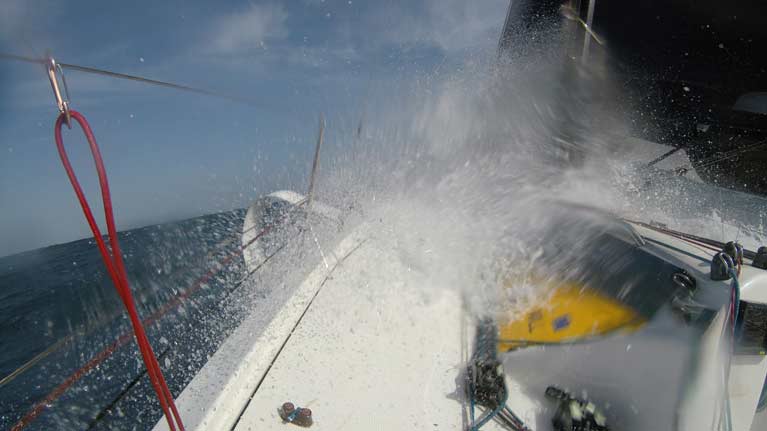
Covid-19
Unfortunately, as we were leaving France, the Covid-19 pandemic was just starting to unfold… Yet another challenge to overcome and also a lot of uncertainty as we all now know. Despite the uncertainty, the end goal was also at the forefront of our minds as to represent Ireland in Malta in October. To accomplish this we had agreed as a team then as soon as the various lockdowns around the world were lifting or showing signs of lifting, we were straight out to France to put the boat back in the water and get sailing. Our plan included getting the boat to Ireland as soon as possible. This was because it had been hinted that the Round Ireland yacht race may be used as the qualifying event for Malta. So on Thursday the 14th of May, with various letters and my father Alistair to help with transport logistics, I was on a ferry from Rosslare to Cherbourg to get to the boat, Pam armed with similar letters was flying on one of the five scheduled flights in total the next day out of Dublin airport.
Plan B - La Solitaire du Figaro
As a team, we had discussed the possibilities and probabilities of the event in October actually occurring and naturally had come up with a plan B. A simple plan but one that would give the team more overall experience of short-handed offshore racing in the Figaro class. The backup was for me to do the solo Figaro circuit including the Solitaire du Figaro to learn the boat and also improve short-handed offshore sailing techniques. Reality quickly came into play three days ago when we were leaving France on the 20th May that plan B would have to be put into place as World Sailing cancelled its World Offshore Championships for 2020.
Sailing home to Dun Laoghaire
 (Above and below) Kenny and Pam arrive back into Dun Laoghaire Harbour Photo: Afloat
(Above and below) Kenny and Pam arrive back into Dun Laoghaire Harbour Photo: Afloat
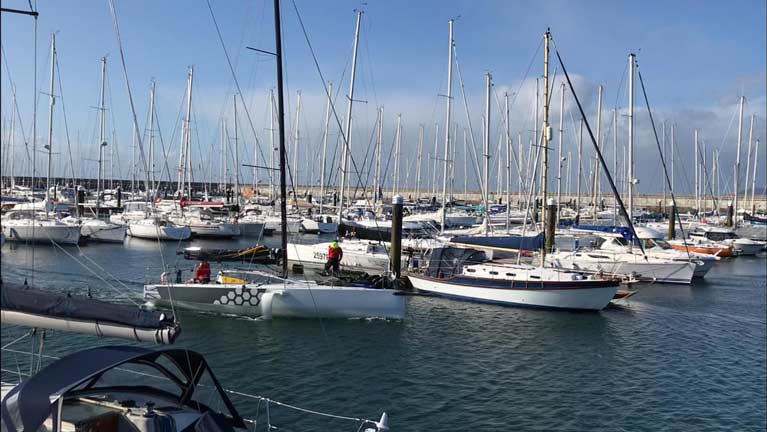
Complying with all the social distancing guidelines in both France and Ireland, we got the boat back to Ireland yesterday evening on the 22nd of May after a two day 317nm spin from Port La Floret. The plan is to train here from Dun Laoghaire Harbour gaining boat handling skills for the next 5 weeks before returning to France for the newly revised Figaro calendar that will include events such as the Drheam Cup, Solo Concarneau, La Solitaire du Figaro and Spi Ouest (Double-Handed). This should hopefully give us a firm grounding in the boats and discipline of sailing ahead of a double-handed season next year and seeking to qualify to represent Ireland at the rescheduled double-handed offshore worlds, hinted to be in Malta in 2021.
You can follow all our races and adventures for the year ahead on https://www.rlsailingteam.com/ Facebook https://www.facebook.com/RLSAILINGTEAM Instagram https://www.instagram.com/rlsailing/
Dun Laoghaire's Kenny Rumball Skippers Ker 40 'Keronimo' in Sweden's Round Gotland Race
Dun Laoghaire's Kenny Rumball is skippering the Ker 40 Keronimo in the Round Gotland Race that started yesterday.
It's not Rumball's first time in charge of the Swedish Grand Prix yacht. Last month he steered her to second in RORC's Cervantes Trophy Race.
In a tongue in cheek race entry bio on the official Round Gotland website, the Dubliner is described as 'Chief Comforts Officer'.
Rumball is sailing without his regular offshore mate, Barry Hurley, also of the Royal Irish Yacht Club on this occasion.
Tracker is here.
Irish National Sailing School Viking Ship Plan for Dun Laoghaire Harbour
Go–ahead Irish Sailing School, the INSS, are planning to moor a 50–foot Viking Ship in front of their Dun Laoghaire Harbour premises at the West Pier in Dun Laoghaire.
In August, School Principal Kenneth Rumball co-ordinated a 'Battle of Dun Laoghaire Harbour' fought By 'Viking invaders'. It was a free and family–friendly event that featured battles, longboats and a Viking village that was a collaboration between Dun Laoghaire Harbour, actors from the Viking TV series and the INSS to celebrate the harbour's bicentenary.
As well as sailing instruction, the leading Irish sailing school also provides marine location services, including logistic work for the hit TV series 'Vikings', filmed in Wicklow.
The success of August's battle has led the school to develop plans to moor one of the longships in Dun Laoghaire's Coal Harbour as a water-based tourist attraction.
Read more from WM Nixon here: Dun Laoghaire Sailing's Cage Rattled By Malahide Boating Dynamo
Fastnet Race Justice for Irish National Sailing School's Jedi
With 312 entries in the IRC divisions alone, and numbers pushing towards the 400 mark when all classes are included, the record-breaking Fastnet Race 2017 was surely on the edge of becoming an unwieldy beast as it got under way in classic style westward down the Solent on Sunday August 6th. Add in the fact that the mountain of results was only being finalised on the following Friday, when the rhythm of the sporting week was already starting to bring major weekend arena events to the top of the demanding media agenda, and you inevitably have the prescription for a hasty allocation of subsidiary awards which risks seeing some trophies going to the wrong recipients. W M Nixon takes a look at how it all eventually came right in one very special case.
The Roger Justice Trophy is a handsome cup in the Rolex Fastnet Race array of silverware, yet it’s a cup for which nobody specifically competes. It goes to whichever offshore sailing school has done best in the overall results, and there were upwards of thirty boats eligible for it in 2017. But as Kenneth Rumball of the Irish National Sailing School tersely comments, if you’re racing a school boat in the Fastnet and you’re only interested in the Roger Justice Trophy, then you’re missing the point completely.
For as he sees it, the entire purpose of taking your training vessel in the Fastnet is to throw the tyro crew into open competition. You’re not seeking any special concessions because you’re a school boat. On the contrary, you’re there because this is the big boys’ game. You’re playing by the big boys’ rules. And you’re taking on the very best of them head-to-head, with no concessions expected.
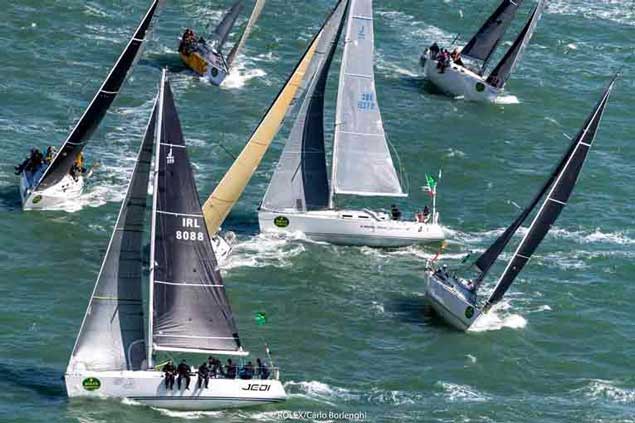 Head-to-head competition in the open fleet with no concessions expected. Jedi makes a dream of a port tack start in the Rolex Fastnet Race 2017. And yes, she did pass clear ahead of that boat (top left) romping in on starboard tack. Photo: Rolex/Carlo Borlenghi
Head-to-head competition in the open fleet with no concessions expected. Jedi makes a dream of a port tack start in the Rolex Fastnet Race 2017. And yes, she did pass clear ahead of that boat (top left) romping in on starboard tack. Photo: Rolex/Carlo Borlenghi
The story of how the Irish National Sailing School in its busy corner of the Inner Harbour of Dun Laoghaire came into being in the 1970s is now the stuff of legend. Our most recent detailed look at it came in this blog on 16th May 2015, when we headlined with an account of how school founder Alistair Rumball had expanded his additional advisory and boat provision role with the TV and movie business by organising the longships for the television series Vikings, thereby providing an additional income source to help the INSS through the depths of the economic recession.
In this he had the full support of his wife Muriel, who is the overall administrator of the school. And as it was a situation that demanded sacrifices in terms of working hours, pay and conditions which could never be expected from a non-family employee, their son Kenneth jacked in his job in Dublin as an accountant, and became the on-water principal.
By 2015 the light at the end of the tunnel had become a warm, steady and reassuring glow, and when we were there on a May evening, things were definitely on the up-and-up. In the basic but very functional premises, the first committee meeting of the recently-formed Irish National Sailing Club was being held. It had been set up in order to organize races and provide sailing school graduates with a club membership to comply with major event requirements, and to reflect that while the INSS was definitely a school, for many participants it had attractive elements of a club about it.
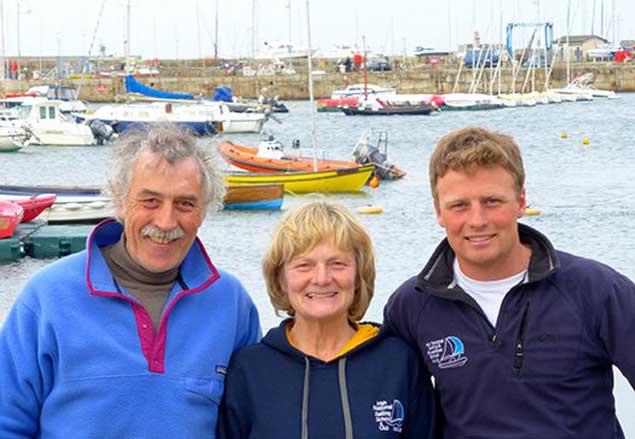 Alistair, Muriel and Kenneth Rumball – the family’s devoted work with the Irish National Sailing School has made an enormous contribution to Irish sailing. Photo: W M Nixon
Alistair, Muriel and Kenneth Rumball – the family’s devoted work with the Irish National Sailing School has made an enormous contribution to Irish sailing. Photo: W M Nixon
Alistair was busier than ever with Viking ships which had to be replaced from time to time just wherever he could find a builder who could comply with strict standards and a tight budget, and Kenneth was thinking ahead to further development of the uses of a fleet which included craft up to 1720s size, with the Reflex 38 Lynx in prospect as the school flagship with serious offshore racing possibilities.
In the intervening two and more years, many things have happened. Sadly, Alistair’s brother Arthur died much mourned in December 2016. He had been a cornerstone of the school structure as he was in charge of maintenance of the enormous, very varied and growing training fleet, but he’d trained his staff well, and his high standards have been maintained.
But by December 2016, the club’s fleet structure had been enhanced with the addition of the Reflex 38 which Kenneth had skippered to tenth overall in the fleet of 63 boats in the Volvo Round Ireland Race, winning the sailing schools division.
Yet despite this successful debut on what was now the international scene, they’d already concluded that the technically difficult Reflex 38 was not the ideal offshore racing boat for a Dun Laoghaire-based sailing school to make the best use of the unique combination of possibilities which Dublin Bay and its adjacent long distance racing areas provided.
Longterm readers of Afloat.ie don’t need reminding that we have been banging on for a very long time indeed about just how ideal is the J/109 to embody Dublin Bay’s noble One-Design tradition. So when word came through that the Irish National Sailing School had bought the 2002-built J/109 Jedi II with the aim of serious campaigning in the 2017 season, it was very good news indeed.
It’s the perfect package – a very manageable boat, straightforward to sail with a bowsprit and asymmetricals, plenty of sister-ships to pace yourself against offshore, and a cracking fleet in Dublin Bay to give INSS students a taste of inshore One-Design racing at its very best.
 Kenneth Rumball in the INSS’s decidedly basic premises on Dun Laoghaire’s Inner Harbour this week. He took a 15-year-old J/109 and transformed her into a race winner. Photo: W M Nixon
Kenneth Rumball in the INSS’s decidedly basic premises on Dun Laoghaire’s Inner Harbour this week. He took a 15-year-old J/109 and transformed her into a race winner. Photo: W M Nixon
But there was much to be done to bring Jedi up to Kenneth Rumball’s demanding requirements. At 29, he was already a successful veteran of the Round Ireland, Fastnet, Middle Sea and Sydney-Hobart Races. So a year’s campaigning culminating in the Rolex Fastnet Race 2017 demanded a programme of painstaking remedial work to optimize Jedi for the serious stuff.
In doing this, he was helped by two things. Arthur Rumball’s legacy was a skilled workshop staff who could assist Kenneth in reducing superfluous weight in Jedi – in all, about 350 kilogrammes of unnecessary equipment and “ornaments” came out of her, while her underwater hull was taken down to the gelcost and her keel got a proper fairing. But as well, Andrew Algeo had also recently also joined the Dublin Bay J/109 fleet with the newer Joggerknot. He too was engaged in optimizing her for the high standard of racing of the Dun Laoghaire fleet, so between them they provided a real Brain’s Trust for the exchange and implementation of ideas.
At a high point in January 2017, it looked as if the INSS might have two boats in the Rolex Fastnet Race 2017. Kenneth had just come back from racing the Sydney-Hobart in a First 40, and was filled with enthusiasm for the potential of having the school’s two boats in the Fastnet. So he set up two Rolex Fastnet Race 2017s entry procedures side-by-side on two separate laptops on the school’s work table. There was just time to have everything in order as the closing date arrived, and for those who have had difficulty in even getting their Fastnet Race entry considered, it will be maddening to hear that both INSS boats made the cut.
But over the coming months, harsh reality intervened as the sheer logistics challenge of managing and manning two proper school entries from a base in Dun Laoghaire in a race starting off Cowes became apparent, and Lynx’s slot was returned to the RORC office.
Thanks to this slimming of the operation, things were looking very good for the season’s campaigning of the revitalized Jedi. Early races were providing increasingly encouraging results, and the places in the training programme towards participation in the Rolex Fastnet Race 2017 had been quickly snapped up and money paid up front by a diverse line-up of trainees. This meant they’d comfortably comply with the RORC’s fairly modest definition of a sailing school entry as a boat which was sailing school-owned, and had a 50/50 lineup between experienced and trainee crew.
It has to be remembered that this was all taking shape as the INSS was entering its busiest time of the year in its core activity of being a sailing school which gets hundreds of people from every background afloat in a wide variety of boats in Dublin Bay, a significant proportion of them for the very first time.
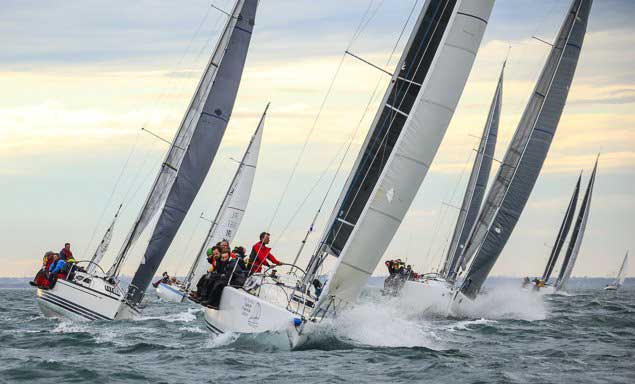 Jedi leading the offshore fleet. The combination of Dublin Bay One-Design sailing with the J/109s, combined with readily-available offshore racing, offers a superb opportunity to learn – but only for those who can stick the pace. Photo: Afloat.ie
Jedi leading the offshore fleet. The combination of Dublin Bay One-Design sailing with the J/109s, combined with readily-available offshore racing, offers a superb opportunity to learn – but only for those who can stick the pace. Photo: Afloat.ie
So it was a cruel blow when the wheels came off the Jedi programme on May 13th with the ISORA Holyhead-Dun Laoghaire Race. A rugged event with wind-over-tide conditions and the sea at its coldest, it may have seen hardened veterans like Paul O’Higgins and his tough crew in the JPK 10.80 Rockabill VI revelling in the going to win, and there was also good going by second-placed Transatlantic veteran Conor Fogerty in the Sunfast 3600 Bam. But aboard Jedi there was misery and seasickness rampant among the trainees, and at race’s end three of them pulled out of the Fastnet programme.
They’d already paid up, but in time an amicable financial settlement was reached, and Kenneth Rumball set about filling the empty places, though as the end of May approached, he was not feeling optimistic. Yet they managed to get a crew with the right configuration together for the vital Dun Laoghaire to Dingle Race on 11th June, seen as a key qualifier and training event, yet here too things went pear-shaped.
The unbelievably rugged beat round Ireland’s rocky southeast corner took a savage toll with wholesale retirals, and one of Jedi’s crew became ill beyond seasickness. It was feared they were having a stroke, and the whole purpose on board became focussed on getting into Dunmore East as quickly as possible and getting the casualty to hospital, where recovery was complete. But by the time that had been done, it was clear they were out of the race, and they sailed disconsolately back to Dun Laoghaire to pick up the pieces.
Fortunately the rest of the crew were still more than game for the Fastnet challenge, and they’d ISORA’s Lyver Trophy Race on June 30th before the Volvo Dun Laoghaire Regatta from 6th to 9th July to provide the final necessary qualifier. But the race was postponed because of a severe gale, put back to a date three weeks hence, which would leave the final Jedi qualifier only a narrow window of opportunity.
Yet suddenly, they were in a time of hope. Jedi with many of her potential Fastnet crew on board had a great Volvo Dun Laoghaire Regatta. They finished second in class, and the team were bonding in a very encouraging way.
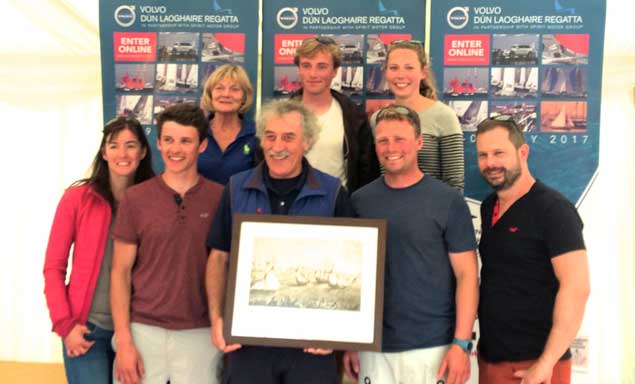 When it all finally started to come together. Alistair & Muriel Rumball with Jedi’s crew at the prize-giving ceremony for Volvo Dun Laoghaire regatta, July 9th 2017. To celebrate Dun Laoghaire’s 200th Anniversary, one of the prizes was a picture of the first regatta at the harbour, in 1828.
When it all finally started to come together. Alistair & Muriel Rumball with Jedi’s crew at the prize-giving ceremony for Volvo Dun Laoghaire regatta, July 9th 2017. To celebrate Dun Laoghaire’s 200th Anniversary, one of the prizes was a picture of the first regatta at the harbour, in 1828.
Two weeks later, the Lyver Trophy was sailed on July 21st from Holyhead round Rockabill to Dun Laoghaire, and they’d a good race of it. Although the winner was the all-conquering J/109 Sgrech (Stephen Tudor), Rumball and his crew were right in the thick of it chasing in a three-way match race with sister ship Mojito (Peter Dunlop & Vicky Cox), and they finished with the feeling that at last they had the basis of a proper Fastnet challenge, albeit with just a fortnight to go to the start.
So the fact that Kenneth Rumball finally filled in the form to define them as a sailing school entry with less than a fortnight to go to the start of the Rolex Fastnet Race 2017 may have had something to do with the subsequent initial post-race mis-allocation of an award. He himself regarded the sailing school thing as very secondary to the core Jedei theme of being in the midst of the main fleet, and in any case he had the prodigious logistical challenge of transferring the focal point of the campaign from the school office in Dun Laoghaire to the Solent.
In times long past, anyone doing the Fastnet Race expected to spend the days beforehand berthed in Cowes. But with current entry numbers and the Solent area’s overcrowded situation, being in Cowes is if anything a disadvantage for a campaign from Dublin with limited resources and very extended lines of communication. In the circumstances, the way the Jedi team handled this was real textbook stuff.
Time and personnel resources were of the essence, so they arranged for the boat to be delivered on a semi-professional basis to the relative peace and quiet of Mercury Yacht Harbour well up the Hamble River over on the Solent’s mainland shore. And while the rest of the crew flew over in time to allow three clear days for final preparation, Kenneth and Lorcan Tighe stocked up a mini-bus to double as shore transport and a workshop/storeroom, and they took the Holyead ferry and drove it post-haste to the Hamble
 Just ever so slightly nervous….Jedi crew in Mercury Yacht Harbour on the River Hamble early on the morning of the start of the Rolex Fastet Race 2017
Just ever so slightly nervous….Jedi crew in Mercury Yacht Harbour on the River Hamble early on the morning of the start of the Rolex Fastet Race 2017
Lorcan Tighe (17) may have been be Jedi’s most junior crewman in terms of age, but he was one of the most experienced on board. From Killiney in Dublin, his family is non-sailing though his dad is into scuba diving. But when he was just six, Lorcan took a week-long course at the INSS, and was hooked. So although he now has his own Laser based at the National YC, his heart stays with the INSS where he instructs evenings and weekends and during holidays (he’s in final year at Marian College in Ballsbridge). And he’s mad keen on the offshore thing, taking on the hugely challenging job of being the bowman on Lynx during the 2016 Volvo Round Ireland Race.
He’s a talented helmsman too, so he was very much on the “experienced sailor” side of the equation aboard Jedi, where the co-skipper with Kenneth Rumball was Conor Kinsella (28), who’s from Tullamore and works in finance.
As for the “trainees”, they were very much of the Ireland of today. Deirdre Foley works in banking, Kylie McMillan (29) is in financial consulting, Keith Kiernan (41) is in insurance, George Tottenham (38) is in windfarms, and Fearghus McCormack – whom Kenneth Rumball reckons to be about 40 – is Mine Host of that splendid establishment, the Merrion Inn in the heart of Dublin 4.
Kenneth Rumball is refreshingly non-ageist, so apart from Lorcan Tighe who put us right on his young age, all those ages are only guesses. And Rumball is also refreshingly dismissive of the whole experienced/trainee divide. As far as he and his shipmates were concerned, they were a team, they were crew together, they had a joint mission to perform and everyone was doing his or her very best, and that was all there was to it. There were emphatically no artificial them-and-us divisions on Jedi.
 Here we go…Jedi leaves the now-familiar surroundings of Mercury Yacht Harbour, heading for the start of the Fastnet Race
Here we go…Jedi leaves the now-familiar surroundings of Mercury Yacht Harbour, heading for the start of the Fastnet Race
After such a saga of setback and breakthrough, the Fastnet Race itself could have just been just the concluding chapter in an extraordinary tale of triumph over tribulation. But of course for Jedi’s crew, it was the pinnacle. And it was high adrenalin stuff from the start. Kenneth Rumball set out to take on the best of the opposition head-to-head, and he’d the great Carlo Borlenghi to photograph the moment when Jedi made the sort of clear-away port tack start that is inevitable in traditional Fastnet conditions, yet few manage it so well.
As for the race itself, Deirdre Foley speaks for all with her enthusiastic memories: “I loved every minute of it. Superior planning and attention to tactics/routes etc, a great crew – great sense of humour and craic……on water we had some great wind overnight on our return journey to Plymouth – what looked to be a full moon, nice sea state, Jedi flying along like the wind, for me the best part of a wonderful race”
Young Loran Tighe takes, as you’d expect, a mature overview despite his youth. After all, this is a guy who was working the foredeck of Lynx at the age of 16, racing through the night off Ireland’s Atlantic coast:
“It was great to get the chance to experience the Fastnet Race, but also everything that led up to it including the ISORA series and Volvo Dun Laoghaire Regatta. Great boat, good plan, and in the end, a crew put together that made a super season of it”.
As to the actual race, the irony of it is that it looked as though they were having their closest race with sister-ship Mojito from the other side of the Irish Sea but the reality of a fleet the size of the Fastnet is that you’ve races going on at every side of you, and in the end the way that conditions of tide, wind and whatever pan out will mean that boats a certain size, type, and rating cohort will win out.
Thus everything was going the way of Jedi and her cohort after beating out to the Fastnet in classic style. The overall leader on IRC at the Rock was the JPK 10.10 Night and Day (Pascal Loison), with fellow French skipper Noel Racine second in sister-ship Foggy Dew, while third was Ireland’s Paul Kavanagh in the vintage Swan 44 Pomeroy Swan.
Their ratings are 1.003, 1.002 and 0.985 respectively, which tells us much. Mojito at the stage was at he best place in the race, she was ninth overall rating 1.010, while Jedi was in contention, rating 1.008 and in 11th place overall, just one place ahead of RORC Commodore Michael Boyd of the RIYC racing the first 44.7 Lisa.
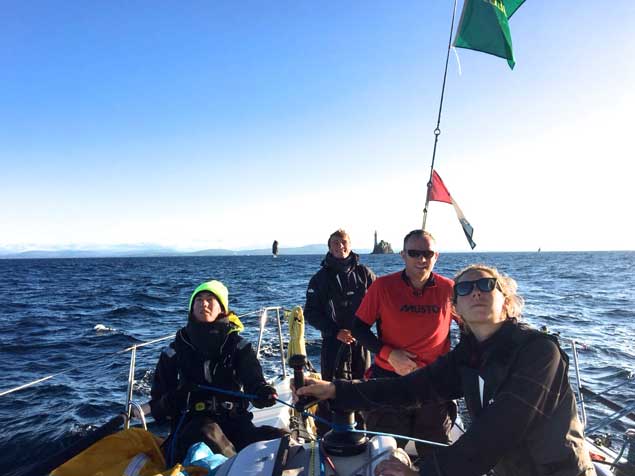 On top of the world….with 17-year-old Lorcan Tighe on the wheel, Jedi heads for Plymouth from the Fastnet Rock lying 11th overall in the 312-strong fleet
On top of the world….with 17-year-old Lorcan Tighe on the wheel, Jedi heads for Plymouth from the Fastnet Rock lying 11th overall in the 312-strong fleet
But on the fast sail back to Plymouth, it was boats around the 40ft mark which carried the favourable conditions best, and the JNA 39 Llan Ael 2 (Didier Gaoudoux, France) rose up the rankings from 29th overall at the Rock to become overall winner, while Lisa was remarkably consistent to move up from 12th to 8th.
But for the smaller J/109s, things became distinctly unfavourable, and though Jedi did indeed run like the wind, getting ahead of Mojito despite seeing her A3 blow out when it shouldn’t have, by the time she was in the final approaches to Plynouth the bite had long gone gone from the wind, and she cascaded down to 58th overall.
She was still very much the first J/109, and while she was 8th in IRC 3, she was first in IRC 3B for boats doing their first Fastnet. There was a cherished medallion in line for that, for a first in class in the greatest Rolex Fastnet Race ever held is something very special.
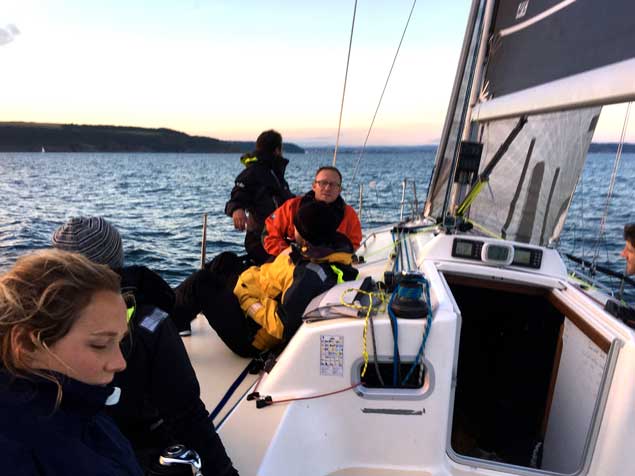 Aboard Jedi approaching Plymouth and the finish as night draws on, Thursday 10th August. The wind is slipping away, and she no longer holds a top overall placing, but is leading Class 3B.
Aboard Jedi approaching Plymouth and the finish as night draws on, Thursday 10th August. The wind is slipping away, and she no longer holds a top overall placing, but is leading Class 3B.
On that crowded Friday afternoon in Plymouth with mountains of results figures still being assimilated and analysed, the Roger Justice Trophy went to a Sailing School Farr 60. Something strange here. A scan of the results showed that Jedi been well ahead of that Farr 60 on corrected time. But with everyone going their various ways with Conor Kinsella heading off to retrieve the mini-bus from the Hamble while Kenneth Rumball cruised Jedi home, sorting it out could be left to a later date.
With that Class 3B win under their belt, there was time enough to see about putting the record straight. And when they later contacted the RORC office, they were told that there had indeed indeed been an error, and the winner of the Roger Justice Trophy was Irish Offshore Sailing of Dun Laoghaire in the Sunfast 37 Desert Star, thereby repeating Ronan O Siochru’s success of 2015.
So then they’d to get back to the number crunchers again, and gently suggest to them that it was indeed a Dun Laoghaire-based sailing school which had won the Roger Justice Trophy, but it was a different one - it was the Irish National Sailing School and the boat was called Jedi.
 Jedi gets Justice – RORC Commodore Michael Boyd, Committee Member Lucy Reynolds, and Kenneth Rumball as the Roger Justice Trophy finally reaches its rightful winner in RORC headquarters in London last week.
Jedi gets Justice – RORC Commodore Michael Boyd, Committee Member Lucy Reynolds, and Kenneth Rumball as the Roger Justice Trophy finally reaches its rightful winner in RORC headquarters in London last week.
It’s understandable that it happened. After all, Jedi’s final fully-qualified crew list as a sailing school was only submitted to the race office with about ten days to go to the start of the race. The sheer weight of data flying about by this stage must have been smothering for those handling it.
But it all came right at the end, though admittedly it was the very end. At an awards ceremony in the RORC in London last week, at the last moment Jedi was finally called forward to receive the Roger Justice Trophy. Forget that old saying about justice delayed is justice denied. In sailing, it’s acceptable if justice is done in due course, and is seen to be done.
Kenneth Rumball Galway Talk – from Optimist Sailing to Offshore Racing & Running a Sailing School
Irish National Sailing School Principal Kenneth Rumball heads west this month to give a chat about his sailing career. All are welcome to Galway Bay Sailing Club on Wednesday,18th of January at 8pm. Here's what the Oranmore club can expect:
I still remember my first day sailing, it was a typical miserable so called 'summers day' in Sutton north of Dublin. Dad (Alistair Rumball) was helping to get a sailing school going over there. There was a group of us in shortie wetsuits and buoyancy aids freezing standing in chest deep water waiting for our turn to take command of probably a heavily reefed topper dinghy. I had already figured out what the tiller did and on the way to sailing that day had figured out what the piece of rope at the back did, apparently it made the boat go faster. I hopped in on my go, held the tiller and pulled on the rope, accelerated away and capsized! I was hooked!
From those early days it has been a whirlwind 22 years learning, teaching, racing and above all sailing a huge variety of boats including 420s, 49ers, Rs200s RS400s, Fireballs, J109s, J80s, the list is pretty endless. Taking the teaching from a hobby to a full profession and career has been an adventure in itself aiming to do it all better and faster than anybody can imagine.
Above all sailing has thoroughly taken over my life and if you would like to hear some of my experiences sailing dinghies around the cans or racing thoroughbred race boats offshore at the highest level or even hear what it is like to pursue a career in the industry.
Irish National Sailing School's Lynx is First School Boat in Round Ireland Yacht Race
INSS School principal and skipper Kenneth Rumball reviews his tenth place overall in Volvo Round Ireland 2016 on board the INSS Reflex 38, Lynx.
The idea for the Irish National Sailing & Powerboat School to compete in the Round Ireland Yacht race was hatched even before the company planned to enter into the yachtmaster business. In fact when selecting a yacht for our competent crew, dayskipper and yachtmaster teaching duties, we made sure to select a boat that could not only fulfil our teaching duties but could look after an amateur crew while also competing at the highest level offshore.
Our Reflex 38 spent her first year primarily away from racing duties before undergoing significant race preparation ahead of this year’s Round Ireland Yacht Race. Our hull was stripped back and freshly antifouled, electronics upgraded, sheets and halyards replaced along will a full sail valet and re-measurement, this all topped off with a full IRC re-measurement in an effort to reduce our TCC ahead of the race.
Meanwhile we started to advertise our campaign for the year ahead which included not only the race but 2 dedicated training weekends along with 4 ISORA training races to ensure our crew was fully prepared along with the boat ahead of this year’s race. Lynx performed well in this training races, coming 4th in the Dun Laoghaire to Holyhead and 5th in the Dun Laoghaire to Isle of Man.
All set for the off – the INSS Reflex 38 in Dun Laoghaire
All set, our crew for the Round Ireland left Greystones Marina on the 18th of June for the race we had been preparing for all year. Keeping our noses clean at the start, we got clear early and made big gains by going close in under Wicklow head to be one of the first boats heading south. Pulling nicely in the first two hours, unfortunately we got stuffed in a no wind hole off Arklow. Going again we made good ground to round Tuskar in the leading pack before heading south into the building breeze. The breeze built and built and in changing down through our sails we unfortunately blew out or number 4 jib, eventually bringing us down to storm jib and two reefs in the mainsail, below is one our crew’s recollection at this time;
“I’ve never done a long offshore race before. In fact I only started sailing in April this year, so to say I was out of my depth on the Round Ireland is an understatement. However, I was somewhat cautious and logical, so I completed a few courses with INSS on the run up to the to the race including Sea Survival. During this course, among other things, I briefly learned about a storm jib and trysail. I was told I would probably never need to use this type of sail, but it was good to know. Come Sunday night off Cork, day 2 of the Round Ireland, the breeze picked up and I watched our torn number 4 headsail being bundled down the companion way with a calm call for the storm jib. Jaaaysus, I thought, storm sails, storm sails? What's next? What was the next module on that course? I think it was boarding a life raft...”
Once we got around the Fastnet, we were able to crack sails for a great yacht up the west coast, it got a bit breezy at one point where we blew out our A5 in about 35kts of breeze off Galway which forced us to move to our S3. With the clearing weather, we had a great sail around Tory Island while we calculated our approach to the notorious tides around Rathlin Island. Much to our surprise, we hadn’t done a good job of getting to Rathlin on time, we had in fact NAILED our timing, giving us a great run down toward Belfast Lough.
In good breeze we continued on a beat down the Irish Sea before being becalmed in Dundalk Bay. Here we struggled on the last night to get into the land breeze where unfortunately some of the lead boats got away… We spent most of the last night drifting trying to sniff any breeze out with the code zero. It wasn’t until the next morning off the Baily that we got going again to sail in good breeze into Wicklow.
Lynx finished after 5 days and 49 minutes in the 2016 Round Ireland, coming 4th in class 3, 10th overall and 1st Sailing School boat! It was a fantastic race where I am ever grateful to the crew who for some it was the longest they had ever spent at sea and who all performed admirably throughout the race, they would be a real asset to any offshore campaign in the future. Special thanks also go to Conor Kinsella and Luke Malcolm whom I really would have struggled without their talent and dedication.
See Round Ireland tracker here Afloat's Round Ireland 2016 coverage is here and download overall results here


